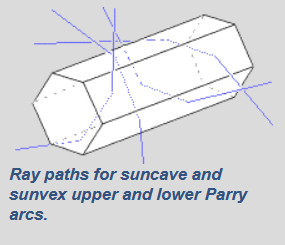Parry Arcs
Parry Arcs: A Rare and Fascinating Atmospheric Optics Phenomenon
Parry arcs, a captivating atmospheric optics phenomenon, have intrigued scientists and sky enthusiasts since their first recorded sighting by William Edward Parry in 1820. These rare halos are formed by column-shaped ice crystals with nearly horizontal long axes, which further align themselves in a unique Parry orientation. The distinct characteristics of Parry-oriented crystals result in a variety of mesmerizing halos, including the elusive Parry arcs.
Understanding the Formation of Parry Arcs
The formation of Parry arcs is intricately linked to the orientation of the ice crystals. Parry-oriented crystals have their long axes and upper and lower prism side faces positioned almost horizontally. When sunlight passes through these crystals, it creates ray paths that intersect the prism side faces inclined at 60°. This interaction gives rise to four possible scenarios, resulting in Parry arcs that are either concave or convex with respect to the sun.
The Dance of Parry Arcs with Changing Solar Altitude
The appearance of Parry arcs varies as the sun's altitude changes throughout the day. At sunrise, a "sunvex" Parry arc is nearly coincident with the upper tangent arc (UTA). As the sun rises higher in the sky, the sunvex arc separates upward, while a "suncave" Parry arc emerges and approaches the UTA. Once the sun reaches an altitude above 25°, a lower sunvex arc becomes visible. These subtle shifts in the positioning of Parry arcs create a mesmerizing dance of light in the atmosphere.
Differentiating Parry Arcs from Similar Halos
To accurately identify Parry arcs and distinguish them from other halos caused by pyramidal crystals or Lowitz arcs, it is essential to anticipate their appearance at the sun's actual altitude. Careful observation and understanding of the unique characteristics of Parry arcs will help differentiate them from other atmospheric optics phenomena.
The Beauty of Parry Arcs: A Testament to Nature's Complexity
The rarity and intricate formation of Parry arcs make them a captivating subject for sky enthusiasts and scientists alike. These mesmerizing halos serve as a testament to the complexity and beauty of nature's optical phenomena. By studying Parry arcs, researchers gain valuable insights into the behavior of ice crystals in the atmosphere and the intricate interplay between light and matter.
Exploring the Rich World of Atmospheric Optics
Parry arcs are just one example of the diverse range of atmospheric optics phenomena that occur in our skies. From halos and sundogs to rainbows and iridescence, the world above us is filled with a plethora of captivating visual spectacles. By delving into the study of atmospheric optics, we gain a deeper understanding of the fundamental principles governing light propagation through various mediums.
Further Research and Observations
Although Parry arcs have been studied for centuries, their rarity and subtle nature continue to make them a subject of fascination and further investigation. Researchers and sky enthusiasts are encouraged to document and share their observations of Parry arcs to contribute to our collective knowledge of these captivating atmospheric optics phenomena.
Conclusion
Parry arcs, a rare and intriguing atmospheric optics phenomenon, captivate observers with their delicate dance of light in the sky. Formed by Parry-oriented ice crystals with nearly horizontal long axes, these halos exhibit unique characteristics that distinguish them from other atmospheric optics phenomena. By studying Parry arcs and unraveling their secrets, we deepen our understanding of the complex interplay between light and matter in the atmosphere. So, keep your eyes to the sky, for you may be fortunate enough to witness the enchanting display of Parry arcs on a clear day.

The changing aspect of Parry arcs with solar altitude. Faint 22° halos and upper tangent arcs (UTA) are included for reference in these HaloSim simulations. At 0° a 'sunvex' Parry arc is almost coincident with the UTA. As the sun rises the sunvex arc separates upward and a 'suncave' Parry arc appears and approaches the UTA. Above 25° a lower sunvex arc becomes visible.
To see this rare halo, anticipate its appearance at the sun's actual altitude - distinguish also between it and halos from pyramidal crystals or even Lowitz arcs.
Ray paths for suncave and sunvex upper and lower Parry arcs.
First recorded in 1820 by Parry during his search for the North West Passage, the arcs are rare. The column crystals with their long axes nearly horizontal which form tangent arcs are even further constrained in the Parry orientation. Parry oriented crystals have their long axes and their upper and lower prism side faces nearly horizontal.
The high degree of orientation produces many different and rare halos. Parry arcs proper result from ray paths through prism side faces inclined at 60°. There are four possibilities and the Parry arcs are called 'suncave' or 'sunvex' depending whether they are concave or convex with respect to the sun.

Note: this article has been automatically converted from the old site and may not appear as intended. You can find the original article here.
Reference Atmospheric Optics
If you use any of the definitions, information, or data presented on Atmospheric Optics, please copy the link or reference below to properly credit us as the reference source. Thank you!
-
<a href="https://atoptics.co.uk/blog/parry-arcs/">Parry Arcs</a>
-
"Parry Arcs". Atmospheric Optics. Accessed on November 26, 2024. https://atoptics.co.uk/blog/parry-arcs/.
-
"Parry Arcs". Atmospheric Optics, https://atoptics.co.uk/blog/parry-arcs/. Accessed 26 November, 2024
-
Parry Arcs. Atmospheric Optics. Retrieved from https://atoptics.co.uk/blog/parry-arcs/.